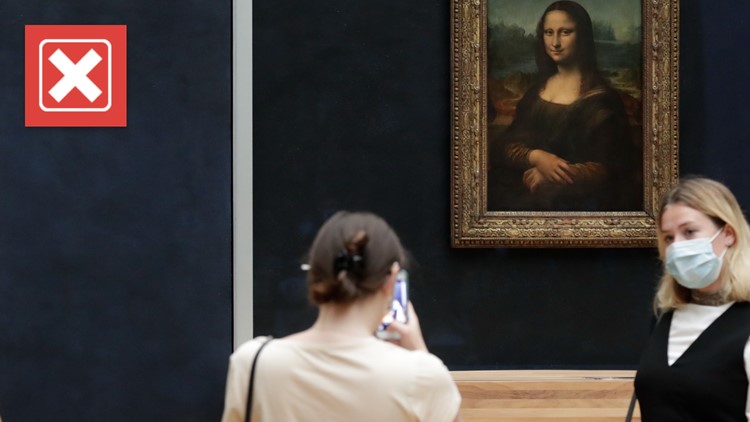The Mona Lisa, on display at the Louvre in Paris, France, is one of the most famous paintings in the world. Painted in the early 1500s by Leonardo da Vinci, the Mona Lisa is the French art museum’s biggest draw, bringing in visitors from around the world.
The painting made headlines this week thanks to an attempt to vandalize it using a cake. Visitors to the Louvre posted photos and videos to social media that appeared to show cake smeared across the lower half of the portrait. Following the incident, one of the most popular Google searches for the Mona Lisa was “Is the Mona Lisa ruined by cake?”
THE QUESTION
Was the Mona Lisa ruined by a cake?
THE SOURCES
James C. Harris, a psychiatrist who wrote about art for the Journal of the American Medical Association
THE ANSWER
No, the Mona Lisa was not ruined by a cake. The painting is housed within a protective glass case, which shielded it from the cake smearing.
WHAT WE FOUND
Although no video has surfaced of the vandal smearing the cake on the painting, several witnesses did share images showing the outcome. One witness simply tweeted out that “someone smashed a cake on Mona Lisa” with an attached video that shows museum staff wiping cake off the famous painting’s display.
According to another witness who posted a similar video and explained what happened in more detail, a man disguised as an elderly woman in a wheelchair allegedly jumped out of the wheelchair and attempted to break the glass protecting the painting. He then smeared cake across the glass before he was stopped by security, according to the post.
The same witness posted a follow-up video in which the perpetrator shouted in French while being escorted out of the building by security. According to translations from news reports, he told the crowd, “Think about the Earth. There are people who are destroying the Earth. Think about it … all artists, think about the Earth — this is why I did this. Think about the planet.”
The Louvre did not respond to a VERIFY request for comment at the time of publishing. The museum told CBS News that the painting had not suffered any damage, and the man had hidden the cake inside his personal belongings.
According to the Louvre’s website, the Mona Lisa has been displayed in a protective glass case at the center of the museum’s biggest room since 2005.
“This special treatment stems partly from the need to ensure the safety of such a famous work, but is also due to conservation requirements: the work was not painted on canvas, but on a panel of poplar wood which has warped over the years, causing a crack to appear,” the museum explains on its website. “To prevent further damage, the Mona Lisa has to be kept in a temperature and humidity-controlled glass case.”
In a June 2013 essay on art and psychiatry for the Journal of the American Medical Association (JAMA) Psychiatry, the late Johns Hopkins psychiatry professor James C. Harris wrote that the Mona Lisa was vandalized multiple times in the mid-20th century before museums displayed it behind glass. There were two attacks in 1956: Someone sprayed the painting with acid and then another person threw a rock that embedded in the Mona Lisa’s elbow later that year. Then in 1974, a woman threw red paint on it to protest a lack of handicap parking while the painting was on loan to a museum in Japan.
To protect the painting from further attacks, the Louvre gave the painting the best security it could offer.
“Today, the Mona Lisa is displayed in a purpose-built, climate-controlled enclosure behind two sheets of bulletproof, triple-laminated glass separated by 25 cm,” Harris wrote. “It is on a wall at a distance from other paintings in the Louvre's Salle des Etats. It has been in this ‘glass box’ since 1974 and is inspected annually; the silica gel used to maintain a safe temperature is regularly monitored. Thus, nonreflective, unbreakable glass protects it from climatic change, camera flashes, and willful attack.”
The painting’s case is apparently just as cake-proof as it is bulletproof.



